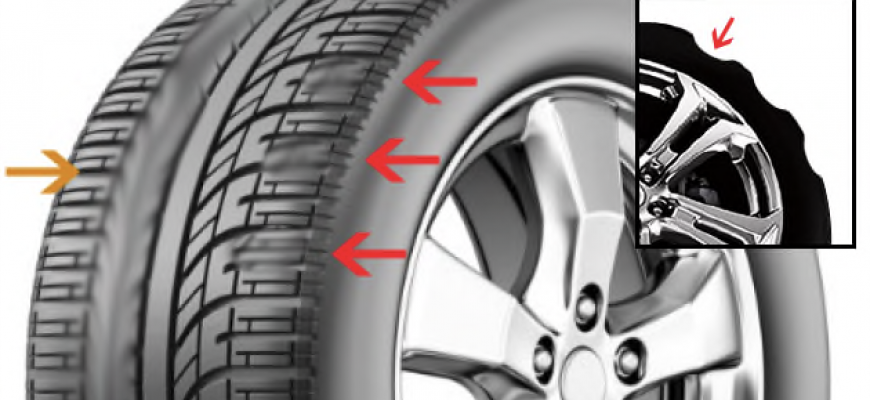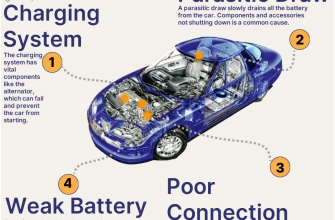Tire cupping is a common automotive issue that can lead to an uncomfortable ride‚ increased wear on tires‚ and potential safety hazards․ As a vehicle owner‚ understanding the causes of tire cupping is essential for maintaining your vehicle’s performance and ensuring your safety on the road․ In this article‚ we will delve into the various factors that contribute to tire cupping‚ how to identify it‚ and what steps you can take to prevent it․
What is Tire Cupping?
Tire cupping‚ also known as tire scalloping or uneven tire wear‚ occurs when sections of the tire tread wear down more rapidly than others‚ creating a wavy or uneven surface․ This can cause vibrations while driving‚ noisy operation‚ and reduced traction‚ leading to compromised vehicle handling․ Understanding the underlying causes of tire cupping is vital for anyone looking to prolong the lifespan of their tires and maintain vehicle safety․
Common Causes of Tire Cupping
- Improper Wheel Alignment: One of the leading causes of tire cupping is misalignment of the vehicle’s wheels․ When the wheels are not aligned correctly‚ it causes uneven pressure on the tires‚ leading to irregular wear patterns․
- Worn Suspension Components: A vehicle’s suspension system plays a critical role in maintaining tire contact with the road․ Worn-out shocks‚ struts‚ or other suspension components can result in excessive bouncing‚ causing the tires to lose contact with the road intermittently and leading to cupping․
- Unbalanced Tires: When tires are not balanced correctly‚ it can lead to vibrations that cause uneven tire wear․ Regular tire balancing checks are crucial‚ especially after installing new tires or if you notice vibrations while driving․
- Under-inflated or Over-inflated Tires: Maintaining the correct tire pressure is vital․ Under-inflated tires can flex excessively‚ leading to overheating and uneven wear‚ while over-inflated tires can wear more rapidly in the center‚ leading to cupping․
- Driving Habits: Aggressive driving‚ such as rapid acceleration‚ hard braking‚ and taking corners too quickly‚ can all contribute to uneven tire wear and cupping․ Smooth driving can help mitigate this issue․
- Road Conditions: Poor road conditions‚ including potholes‚ uneven surfaces‚ and debris‚ can contribute to tire cupping․ Regularly driving on rough terrain can exacerbate tire wear․
Identifying Tire Cupping
Recognizing tire cupping early can save you time and money in the long run․ Here are some signs to look out for:
- Visible uneven wear patterns on the tire tread․
- Increased noise while driving‚ often described as a thumping or humming sound․
- Vibrations felt in the steering wheel or throughout the vehicle․
- Reduced handling performance‚ particularly in corners․
Preventing Tire Cupping
Prevention is always better than cure․ Here are some proactive measures you can take to prevent tire cupping:
- Regular Maintenance: Schedule regular wheel alignment and suspension checks to ensure everything is functioning correctly․
- Monitor Tire Pressure: Check your tire pressure regularly and keep it at the manufacturer’s recommended levels․
- Rotate Tires: Regularly rotating your tires (every 5‚000 to 7‚500 miles) can help promote even wear and prolong tire life․
- Drive Smoothly: Adopt smooth driving habits to minimize stress on the tires and suspension․
- Inspect Tires: Perform regular visual inspections of your tires for signs of wear or damage․
Tire cupping can lead to a range of issues‚ from uncomfortable rides to compromised safety․ By understanding the causes and implementing preventative measures‚ you can keep your tires in optimal condition and ensure a smoother‚ safer driving experience․ Remember‚ a well-maintained vehicle not only enhances performance but also enhances your overall driving pleasure․
For any concerns related to your tires‚ consult a professional mechanic who can provide tailored advice and solutions based on your vehicle’s needs․
Once you’ve grasped the fundamental causes of tire cupping‚ it’s imperative to delve deeper into how this phenomenon impacts your vehicle’s performance and your overall driving experience․ Tire cupping is not merely an aesthetic concern; it has far-reaching implications that can affect safety‚ comfort‚ and even your wallet․
The Ripple Effect of Tire Cupping
When tire cupping occurs‚ the consequences extend beyond the tires themselves․ Here’s how:
- Handling and Stability: Cupped tires can lead to unpredictable handling‚ especially at high speeds or during sharp turns․ This instability can make a vehicle feel like it’s drifting or pulling to one side‚ which can be disconcerting and dangerous‚ particularly in adverse weather conditions․
- Increased Road Noise: One of the immediate effects of tire cupping is the increase in road noise․ As the uneven tread interacts with the road surface‚ it produces a thumping or humming sound that can drown out your music or conversations‚ making for a less enjoyable driving experience․
- Vibration and Driver Fatigue: The vibrations caused by cupped tires can lead to driver fatigue over long distances․ As the steering wheel vibrates‚ it demands more attention‚ causing discomfort and distraction․ This can be particularly problematic during long road trips or commutes․
- Accelerated Wear on Other Components: Cupping doesn’t just wear down the tires; it can also accelerate wear on suspension components‚ wheel bearings‚ and steering systems․ Over time‚ this can lead to costly repairs and reduced vehicle longevity․
Addressing the Issue: When to Seek Professional Help
Identifying tire cupping early is essential to mitigating its effects․ If you notice any of the symptoms mentioned earlier‚ it’s wise to consult a professional mechanic․ Here’s what to expect during the evaluation process:
- Visual Inspection: A mechanic will examine the tires for uneven wear patterns and check for signs of damage or excessive wear․
- Alignment and Balancing Checks: They will perform alignment and balance checks to ensure that your vehicle’s wheels are set correctly‚ which can address many issues related to cupping․
- Suspension Inspection: The suspension system will be examined for wear and tear‚ with any necessary repairs recommended to restore proper function․
Cost Implications of Tire Cupping
Addressing tire cupping early can save you a significant amount of money in the long run․ Ignoring the problem can lead to:
- Frequent Tire Replacements: Tires that wear unevenly will need to be replaced sooner than expected‚ increasing your overall tire expenses․
- Suspension Repairs: If cupping is allowed to continue‚ it could lead to costly repairs on suspension components‚ which can be significantly more expensive than maintaining tires․
- Fuel Efficiency Drops: Cupped tires can lead to increased rolling resistance‚ which may cause your vehicle to consume more fuel‚ adding to your operating costs․
Educating Yourself on Tire Maintenance
Beyond immediate repair needs‚ proactive education on tire maintenance can empower vehicle owners to prevent cupping and other tire-related issues․ Here are some tips to keep your tires in peak condition:
- Stay Informed: Familiarize yourself with your vehicle’s specifications regarding tire pressure‚ rotation intervals‚ and alignment checks․
- Utilize Technology: Consider using tire pressure monitoring systems (TPMS) to keep an eye on tire pressures in real-time‚ ensuring they are always within the recommended range;
- Consult Your Manual: Your vehicle’s owner manual provides crucial information about tire maintenance and specifications—don’t overlook it!










I learned so much about how to prevent tire cupping. The tips on maintaining proper tire pressure were especially helpful!
I appreciate the detailed explanations and practical advice in this article. It’s made me more proactive about my car maintenance!
This article is incredibly informative! I had no idea how much driving habits could affect tire wear. Thank you for sharing these insights!
This article provides a thorough explanation of tire cupping and its causes. It’s essential reading for any car owner!
Fantastic read! The section on wheel alignment really opened my eyes to how important it is for tire longevity.
Great insights into the impact of suspension components on tire wear. This article is a must-read for anyone who cares about their vehicle!